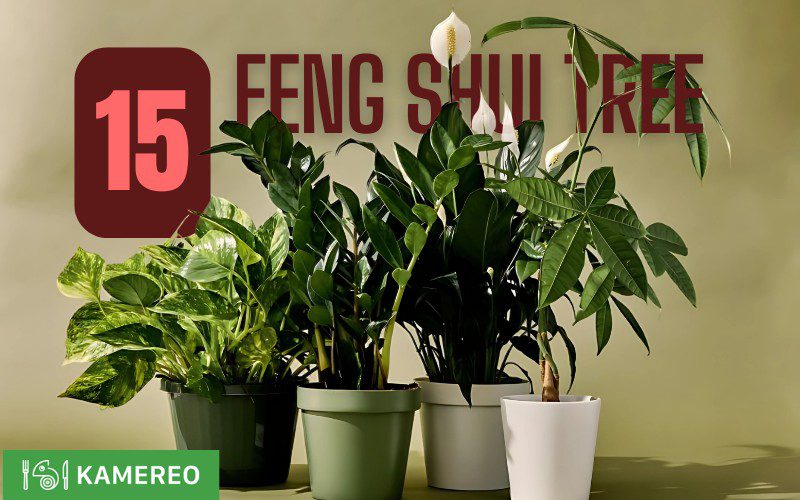Feng shui plants not only serve as decorative elements but also provide significant spiritual benefits. Each plant has its own unique characteristics, helping to improve energy flow and bring positive vibes to the owner. Let’s explore the most popular feng shui plants with Kamereo in this article!
Principles of Choosing Feng Shui Plants
Selecting the right feng shui plant can bring wealth, health, and harmony to a space. Here are some key principles to keep in mind:
- Plants with round, full foliage symbolize completeness and abundance.
- Succulent plants with thick stems and leaves are easy to care for and have good feng shui meanings.
- Plants with sharp thorns, such as cacti, can create negative energy if placed indoors, potentially affecting health and family happiness. However, when placed outside, they can serve as a protective barrier.
- Avoid plants with tangled or overly dense foliage, as they can promote bacterial growth and increase negative energy, disrupting the balance of yin and yang.
- Some wild or forest plants may carry dark energy from their natural environment, making them unsuitable for indoor placement as they could bring bad luck.
- According to the five-element theory, choosing plants that align with one’s birth element can help attract prosperity and success.
- Plants with vibrant colors and lush foliage symbolize abundance and bring good fortune to the owner.
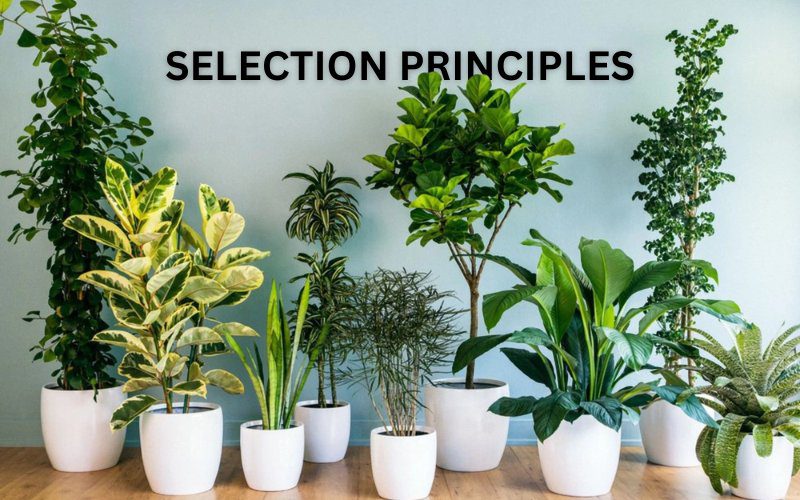
Popular Feng Shui Plants
There are many feng shui plants on the market, each with different meanings. Below are some recommendations to help attract luck and wealth to your home, office, or business space:
Pothos (Epipremnum aureum)
Pothos is a popular climbing plant used for interior and office decoration. In feng shui, pothos represents growth, prosperity, and abundance. Placing it in a home or workspace is believed to bring good luck, financial success, and positive energy.
Pothos is an excellent choice for those who struggle with plant care. It thrives in shaded environments, requires minimal watering, and can be grown hydroponically. The plant’s roots extend both in the soil and from nodes on the stem, allowing it to climb easily.
Beyond its feng shui significance, pothos also absorbs harmful substances like formaldehyde, benzene, and volatile chemicals, improving indoor air quality.
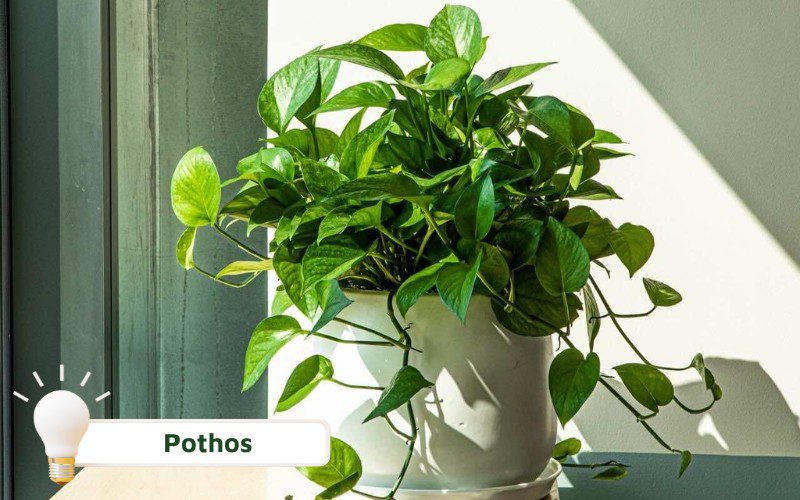
Peace Lily (Spathiphyllum)
The peace lily, also known as the “white sail” plant, is a perennial herbaceous plant known for its elegant beauty and air-purifying abilities. It has deep green, glossy, oval-shaped leaves with pointed tips. The plant’s white flowers grow on long stalks, adding to its graceful and refined appearance.
According to NASA, peace lilies are among the best air-purifying plants, capable of absorbing toxins like formaldehyde, benzene, trichloroethylene, xylene, toluene, and radiation from electronic devices.
In feng shui, the peace lily symbolizes tranquility, purity, and harmony. It is believed to bring good fortune and a sense of peace to homeowners, reducing stress and promoting overall well-being. Additionally, peace lilies help balance energy flow by absorbing negative energy and mitigating conflicting forces in the environment.
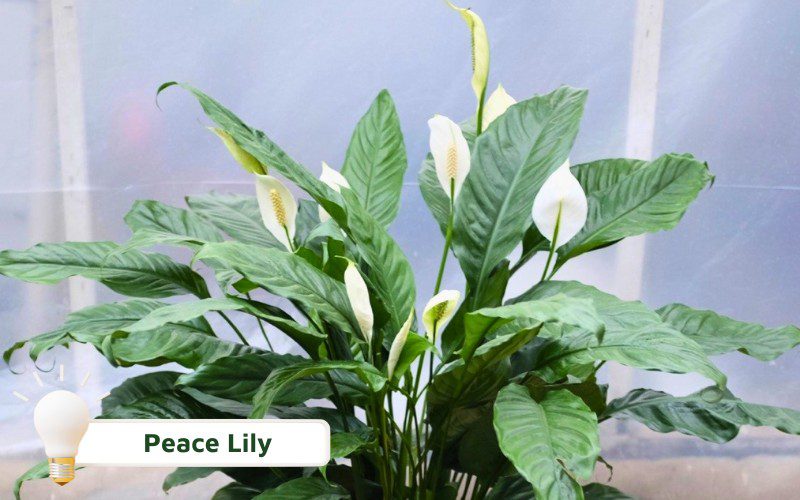
Money Tree (Zamioculcas zamiifolia)
The money tree, also known as the “fortune plant,” is a highly sought-after ornamental plant due to its aesthetic appeal and positive feng shui attributes. Its name suggests wealth and financial prosperity, making it a favorite for home and office decor.
The money tree has thick, glossy green leaves that grow symmetrically along strong, upright stems. It forms dense clusters, symbolizing wealth and abundance. The plant thrives in low-light conditions and requires infrequent watering, making it ideal for indoor settings.
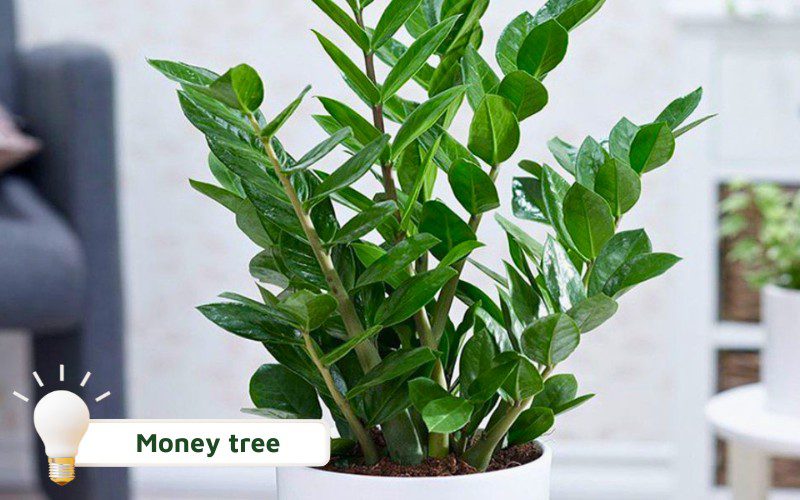
Lucky Bamboo (Dracaena deremensis)
Lucky bamboo, also known as “lotus bud bamboo,” belongs to the asparagus family and originates from Asia.
It has a slender, upright stem with tightly arranged dark green leaves that spiral upwards, resembling a lotus bud. With an average height of 20–25 cm, it is perfect for decorating desks or small spaces.
Lucky bamboo is easy to care for, thrives in low-light environments, and requires minimal watering. It can be grown in soil or hydroponically, depending on personal preference.
In feng shui, lucky bamboo symbolizes purity and spiritual elevation. It is believed to attract wealth, good fortune, and success. Placing this plant in a home or office is said to enhance prosperity and positive energy flow.
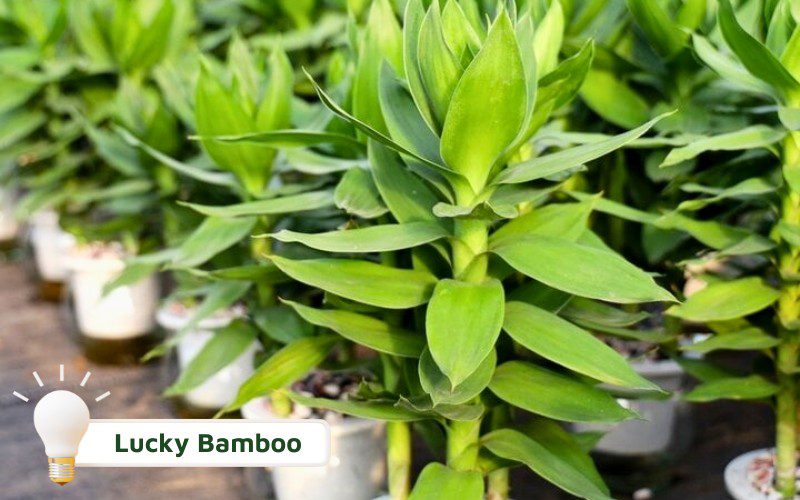
Dracaena Fragrans (Corn Plant)
Dracaena fragrans, also known as corn plant, lucky bamboo, money tree, or prosperity plant, originates from West Africa, Tanzania, and Zambia. Today, it is widely grown worldwide, especially as a popular choice for indoor and office decoration.
In terms of appearance, Dracaena fragrans has a sturdy woody stem with long, glossy green leaves that cluster at the top. Some varieties feature yellow or white stripes along the leaf edges, creating a distinctive and attractive look. This plant is easy to grow and care for, thriving in both indoor and outdoor environments. It can tolerate low light conditions and does not require frequent watering, making it ideal for busy individuals.
In feng shui, Dracaena fragrans symbolizes luck and prosperity. When it blooms, it is considered an omen of wealth and success for the owner. To maximize its positive energy, it is recommended to place the plant in the east or southeast direction of the house.
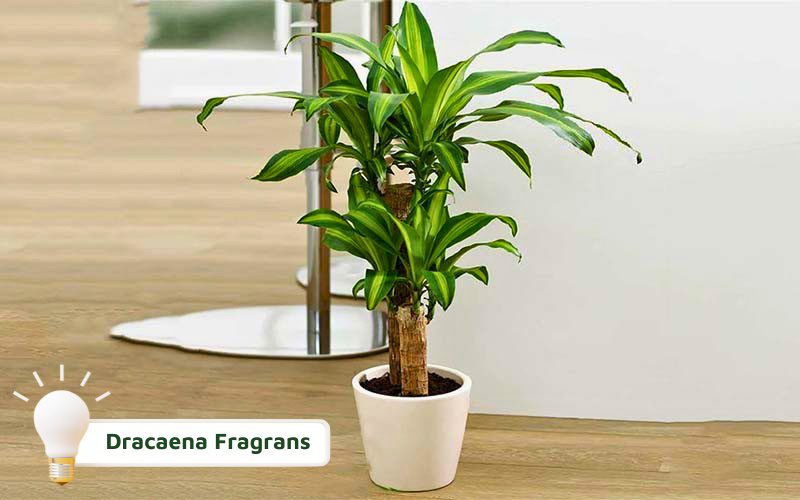
Calathea Makoyana (Peacock Plant)
Calathea makoyana, commonly known as the peacock plant, belongs to the Marantaceae family and originates from the tropical regions of South America. It is highly favored for interior decoration due to its uniquely patterned leaves.
In feng shui, the peacock plant symbolizes good fortune, wealth, and prosperity. Its rounded leaves represent fulfillment, bringing positive energy to homes and businesses.
This plant grows in small clumps and ranges in height from 15 to 60 cm. Its oval-shaped leaves have short petioles, with deep green surfaces adorned with white or cream patterns. The underside of the leaves is typically purple or reddish, adding to its striking appearance.
The peacock plant thrives indoors, preferring shaded areas with high humidity. It grows best at room temperatures between 18°C and 28°C, with an ideal humidity level of around 60%. If the air is too dry, the leaf edges may turn brown and curl.
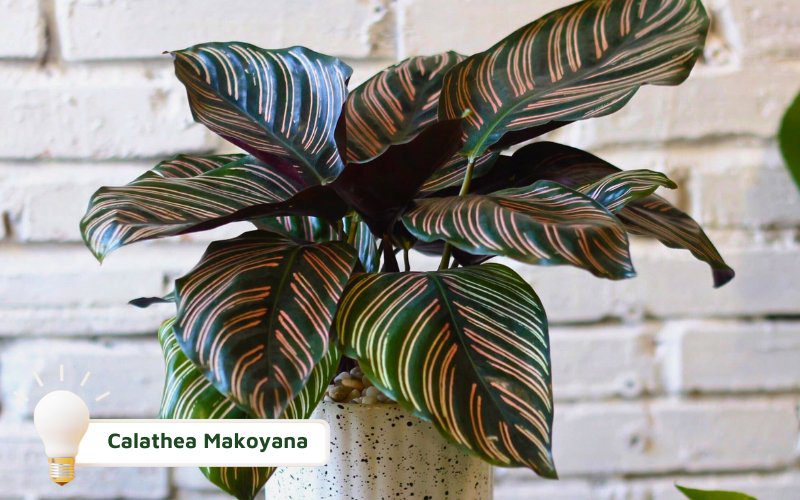
Sansevieria Trifasciata (Snake Plant)
Sansevieria trifasciata, commonly known as the snake plant, belongs to the Asparagaceae family and originates from tropical West Africa. It is a popular indoor plant due to its air-purifying abilities and positive feng shui significance.
The snake plant features long, stiff, upright leaves with green patterns interspersed with yellow or gray stripes, giving it a sleek and resilient appearance. It is highly adaptable, requiring minimal maintenance and thriving in low-light conditions, making it suitable for various spaces.
In both Eastern and Western beliefs, the snake plant is thought to ward off evil spirits and bad luck while bringing prosperity and good fortune to its owner.
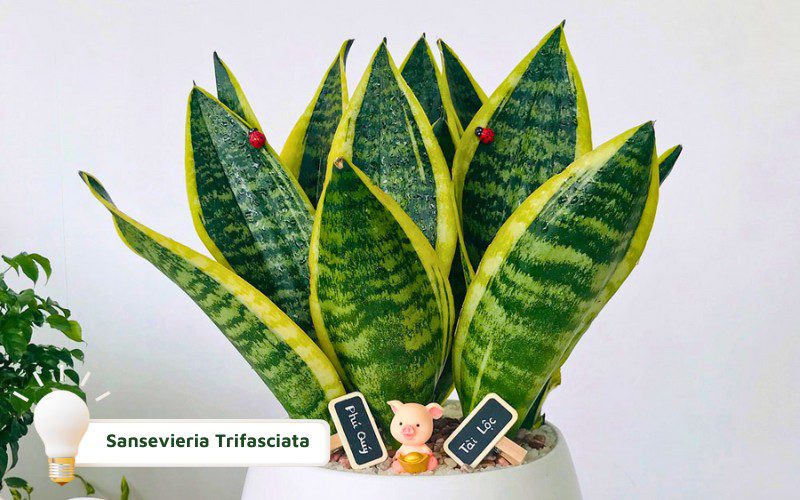
Anthurium Andraeanum (Flamingo Flower)
Anthurium andraeanum, commonly known as the flamingo flower, belongs to the Araceae family and originates from Colombia and Ecuador. This herbaceous plant grows in small clusters and is widely used for interior decoration due to its vibrant appearance and positive feng shui meaning.
The flamingo flower has a short stem and heart-shaped deep green leaves, measuring 18 to 30 cm in length. Its characteristic spathe, often mistaken for petals, has a broad, heart-shaped form and comes in a variety of colors, including red, pink, orange, and white. The actual flowers are yellow and bloom on the spadix, adding a unique charm to the plant.
As a long-lived plant, the flamingo flower thrives indoors, particularly in offices and homes. It prefers humid, well-ventilated environments with indirect sunlight. The ideal temperature range for its growth is between 22°C and 30°C, but it is sensitive to cold temperatures.
In feng shui, the flamingo flower symbolizes luck, wealth, and prosperity. The name “hồng môn” combines “hồng” (red), representing good fortune, and “môn” (door), signifying an open gateway to positive opportunities. Additionally, its heart-shaped leaves and spathes symbolize sincere love and passion.
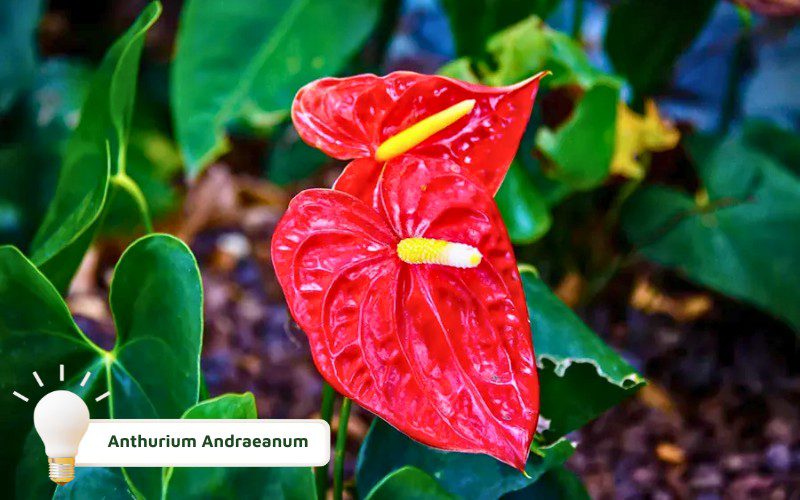
Dieffenbachia Amoena (Dumb Cane)
Dieffenbachia amoena, commonly known as dumb cane, belongs to the Araceae family and originates from tropical America. This plant is a favorite for interior decoration due to its lush green appearance and air-purifying properties.
Dumb cane is a perennial herbaceous plant that typically grows between 50 and 100 cm in height. Its oval-shaped leaves are green with prominent white veins, giving it a distinctive and attractive look. The plant is easy to grow and care for, adapting well to both indoor and outdoor environments. It prefers shaded areas with high humidity and indirect sunlight.
In feng shui, dumb cane is considered a symbol of good fortune and prosperity. It is often gifted during housewarming ceremonies or New Year celebrations as a wish for happiness and success.
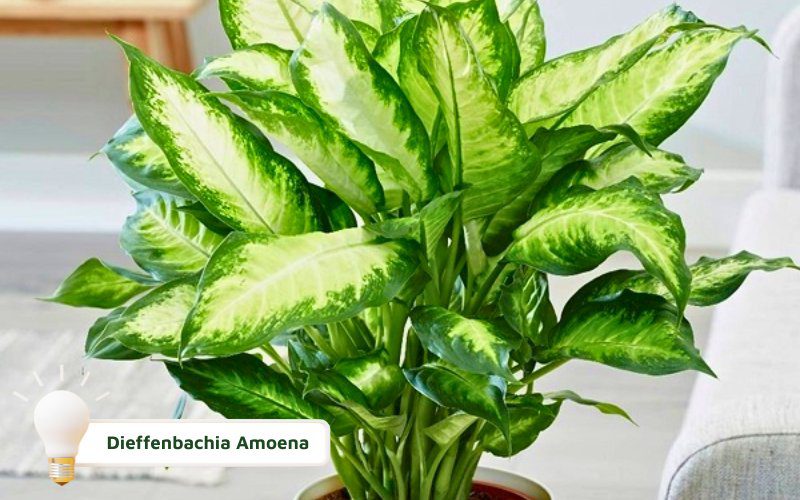
Bromeliad (Guzmania)
Bromeliad, also known as guzmania, torch plant, or ornamental pineapple, belongs to the Bromeliaceae family and originates from the tropical regions of South America.
This herbaceous plant lacks a main stem, with long, sword-shaped leaves arranged in a rosette formation, creating a false trunk. Its flowers grow at the center and come in vibrant colors such as red, yellow, orange, and pink, making it a striking decorative piece.
Bromeliads are easy to grow and care for. They thrive in indirect sunlight, high humidity, and temperatures between 18°C and 24°C. Regular watering is necessary to keep the soil moist but not waterlogged.
In feng shui, bromeliads symbolize luck and prosperity. Their bright, cheerful blooms are believed to attract wealth and bring positive energy to living spaces.
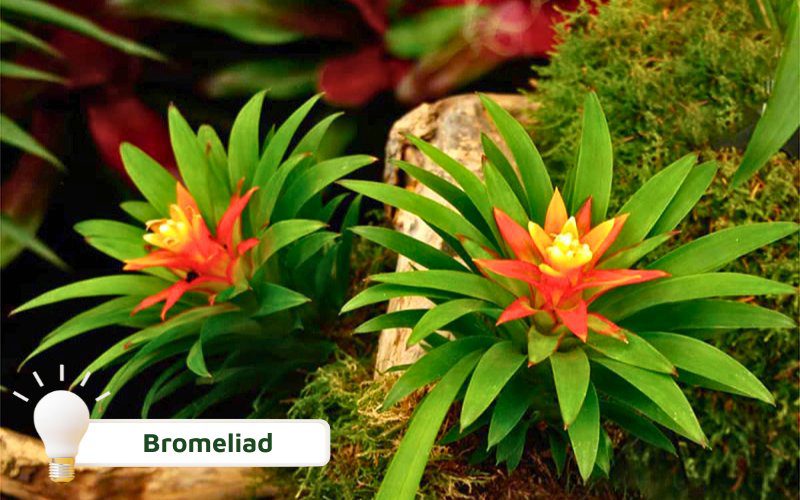
Great Fortune Plant
The Great Fortune Plant, scientifically known as Aglaonema, belongs to the Araceae family and originates from East Asian countries. This perennial herbaceous plant typically grows between 50 and 100 cm in height. Its oval-shaped leaves are deep green with white or silver streaks, giving it a distinctive appearance.
In terms of growth, the Great Fortune Plant adapts well to various environments and is easy to cultivate and care for. It thrives in shaded areas with high humidity and prefers temperatures between 18°C and 24°C. Regular watering is essential to keep the soil moist but not waterlogged.
This plant is considered a symbol of wealth and prosperity. Its green foliage represents the Wood element in feng shui, making it particularly suitable for individuals with Fire, Water, or Wood elements. Growing the Great Fortune Plant indoors is believed to bring good fortune and financial success to the owner.
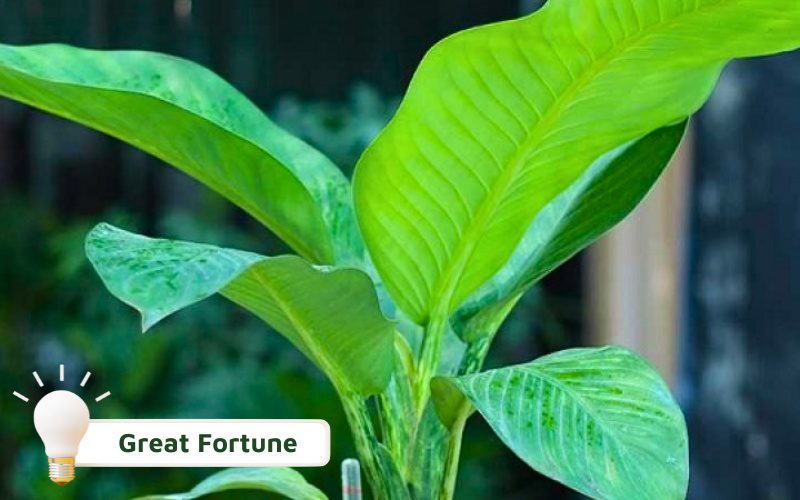
Honeysuckle
The Honeysuckle (Pachira aquatica) is a popular ornamental plant for interior decoration. It is a straight-growing woody plant with lush green leaves that remain vibrant throughout the year. The tree’s trunk is often braided, symbolizing unity and stability.
With a high growth rate, the Honeysuckle adapts well to indoor and office environments. It thrives in indirect sunlight, high humidity, and temperatures between 18°C and 24°C. To ensure healthy growth, regular watering is required to maintain moisture without overwatering.
In feng shui, the Honeysuckle is regarded as a symbol of luck, wealth, and prosperity. Placing this plant indoors is believed to attract positive energy, enhance financial success, and improve overall fortune.
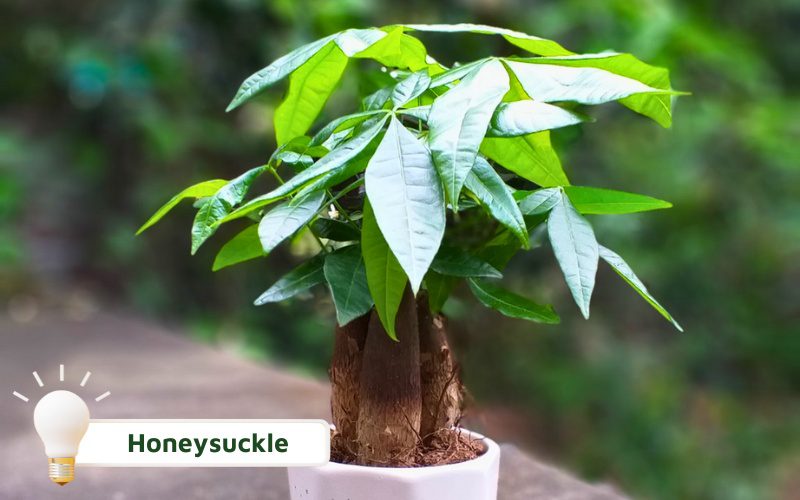
Aglaonema ‘Silver Queen’ (Silver King Plant)
Aglaonema ‘Silver Queen’, scientifically classified under Aglaonema, is a herbaceous ornamental plant. It features oval-shaped leaves measuring 15 to 25 cm in length and around 8 cm in width, with a unique green-and-white or silver-speckled pattern.
This plant thrives in shaded environments, making it ideal for indoor cultivation. It prefers humid conditions and has good water retention capabilities. To maintain optimal moisture levels, watering twice a day is recommended, but excessive watering should be avoided to prevent root rot.
Notably, the Silver King Plant is often referred to as a “wealth-attracting” plant, believed to bring financial success, luck, and prosperity to its owner. Placing it in a home or office is thought to attract positive energy and enhance fortune.

Conclusion
Choosing the right feng shui plant for your space and needs can help attract positive energy, improve fortune, and promote growth in both career and personal life. Stay tuned to F&B Business Tips for more valuable information on feng shui and business success!



